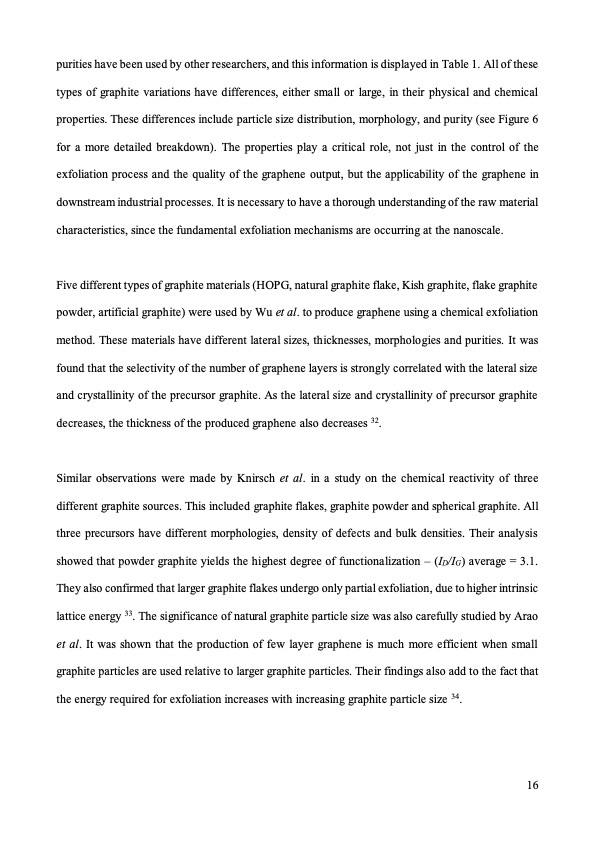
PDF Publication Title:
Text from PDF Page: 016
purities have been used by other researchers, and this information is displayed in Table 1. All of these types of graphite variations have differences, either small or large, in their physical and chemical properties. These differences include particle size distribution, morphology, and purity (see Figure 6 for a more detailed breakdown). The properties play a critical role, not just in the control of the exfoliation process and the quality of the graphene output, but the applicability of the graphene in downstream industrial processes. It is necessary to have a thorough understanding of the raw material characteristics, since the fundamental exfoliation mechanisms are occurring at the nanoscale. Five different types of graphite materials (HOPG, natural graphite flake, Kish graphite, flake graphite powder, artificial graphite) were used by Wu et al. to produce graphene using a chemical exfoliation method. These materials have different lateral sizes, thicknesses, morphologies and purities. It was found that the selectivity of the number of graphene layers is strongly correlated with the lateral size and crystallinity of the precursor graphite. As the lateral size and crystallinity of precursor graphite decreases, the thickness of the produced graphene also decreases 32. Similar observations were made by Knirsch et al. in a study on the chemical reactivity of three different graphite sources. This included graphite flakes, graphite powder and spherical graphite. All three precursors have different morphologies, density of defects and bulk densities. Their analysis showed that powder graphite yields the highest degree of functionalization – (ID/IG) average = 3.1. They also confirmed that larger graphite flakes undergo only partial exfoliation, due to higher intrinsic lattice energy 33. The significance of natural graphite particle size was also carefully studied by Arao et al. It was shown that the production of few layer graphene is much more efficient when small graphite particles are used relative to larger graphite particles. Their findings also add to the fact that the energy required for exfoliation increases with increasing graphite particle size 34. 16PDF Image | graphene production via nonoxidizing liquid exfoliation

PDF Search Title:
graphene production via nonoxidizing liquid exfoliationOriginal File Name Searched:
Graphene-R2-review.pdfDIY PDF Search: Google It | Yahoo | Bing
Salgenx Redox Flow Battery Technology: Power up your energy storage game with Salgenx Salt Water Battery. With its advanced technology, the flow battery provides reliable, scalable, and sustainable energy storage for utility-scale projects. Upgrade to a Salgenx flow battery today and take control of your energy future.
| CONTACT TEL: 608-238-6001 Email: greg@infinityturbine.com | RSS | AMP |